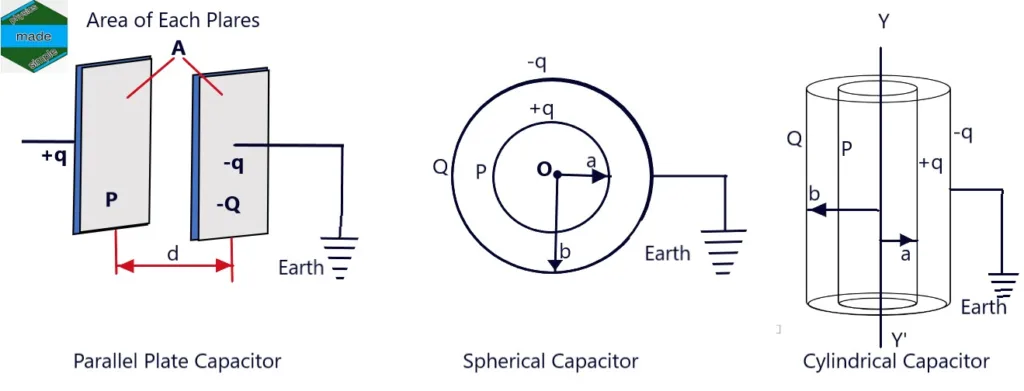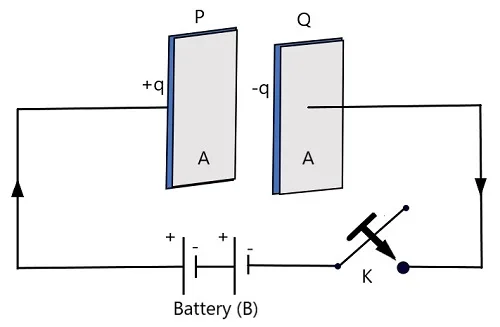Capacitors-12 CBSE
A capacitor is a pair of two metallic conductors that can store energy in the form of an electric charge when one conductor is connected to the earth, while the other conductor is connected to the source of charge to store it on itself. It is a two-terminal electric device and the space between the conductors is filled either with insulating materials that are called dielectrics or with a vacuum.
The Capacitors, depending on the shape of the pair of conductors are of different types- parallel plate capacitor, spherical capacitor, and cylindrical capacitor but the parallel capacitor is the of the simplest design among all the others. The ability of a capacitor to store the electric charge is known as the capacity of the capacitor- Capacitors-12 CBSE
Capacitors-12 CBSE-Electric Capacitance
Electric Capacitance of a capacitor is defined as its ability to store the charge. When a conductor is given some electric charge, it is raised to some potential. As more and more charge is given, its potential increases accordingly. If a charge q is given to the conductor so that it’s potential increases by an amount V, then it is found that, the charge is directly proportional to the potential developed so that we can write,

Where C is constant of proportionality and is called the capacitance of the conductor. It depends upon the shape and dimensions of the conductor. The capacitance of a conductor does not depend upon the material of the conductor, but it depends upon the nature of the medium. ( relative permittivity or dielectric constant) in which the conductor is placed. Thus, the above equation can be written as C = q / V If V = 1 unit, then, C = q Therefore, the electric capacitance of a conductor, is numerically equal to the electric charge which when applied, raises the electric potential through one unit-Capacitors-12 CBSE
Capacitors-12 CBSE-S. I. units of capacitance
The S I unit of capacitance is farad, thus we can write the above eqn. as
C = q / V, if, q = 1 coulomb and V = 1 volt, thus
C = 1 coulomb / 1 volt = 1 farad
Thus, the capacitive of a conductor is said to be one farad, if one coulomb of charge raises its electric potential through one volt. Other smaller unit are microfarad and picofarad, such that
1 microfarad (uF) = 10-6 farad 1 micromicron farad = 1 picofarad = 1 pF = 10-12 farad
capacitors-12 CBSE – working of Capacitor
In order to understand the working of a capacitor, we consider a parallel plate capacitor which is the basic and the simplest structure among all the other types. For simplicity, let us consider a parallel plate capacitor having two metallic plates A and B separated by a small distance d and there is a vacuum in the space between the plates that act as the dielectric medium- Capacitors-12 CBSE
A source of steady emf like an electric cell and a key K is connected across the parallel plate capacitor such that the positive terminal of the cell goes to plate-A and the negative terminal goes to plate -B

When the key is pressed, the electrons from the negative terminal of the source move to plate B and accumulate there, so that plate B becomes positively charged while plate A becomes positively charged relative to plate A. This transport of the negative charge takes place due to the charge (electrons) concentration gradient and will continue till the charge concentration gradient becomes zero or the emf developed across the parallel plate capacitor becomes equal to that of the source. In this way, the capacitor gets charged from zero to maximum q0 This process is called charging of the capacitor

When either the key is open or the battery is now removed from the capacitor circuit, the two plates of the capacitor will keep their respective charges on hold for an infinite time under ideal conditions but practically for some finite time. Thus, this charged capacitor will act as a separate source of electrical energy. The process of removal of the charge from the capacitor’s plates is called discharging of the capacitor as shown.-Capacitors-12 CBSE
It is to be noted that the charging and discharging of a capacitor is exponential. This implies that during the process of charging, the charge takes infinite time to acquire maximum charge q0 and during the process of discharging, the charge takes infinite time to loose the charge completely to q=0

capacitors-12 CBSE- types of capacitors
As we know that a pair of electrodes forms a capacitor, therefore, the types of capacitors depends upon the geometrical structure of the electrodes. There are Mainly three types of capacitors: 1- Parallel plate capacitor, 2- Cylindrical capacitor and, 3- Spherical capacitor as shown below

Capacitors-12 CBSE-Capacity of parallel plate capacitors
A parallel plate capacitor consists of two metallic plates P and Q, each having an area A, separated by a distance d, such that the distance between the plates is very mall as compared to the area of each plate (d <<< A), and air/vacuum is put in between the plates. As the separation between the plates is small, so the fringing of the electric field is negligible at the boundaries. Let us suppose that a source of steady emf is connected across the parallel plate capacitor resulting in the accumulation of +q and -q charges on the plates P and Q respectively and V is the potential difference developed between these plates.-Capacitors-12 CBSE
The capacitance of the parallel plate capacitor when its plates are held in air or vacuum is directly proportional to the area of the plates and is inversely proportional to the distance between the plates of the capacitor and is given by

When the space between the two plates of the parallel plate capacitor is filled with a dielectric medium of dielectric constant K, then the electric field between the two plates is given by. -Capacitors-12 CBSE

This equation gives us the capacitance of a parallel plate capacitor with the dielectric medium of dielectric constant K placed between its plates. Thus, it is concluded that the capacity of the capacitor increases K times when a dielectric medium of dielectric constant K is inserted between the plates of the capacitor.-Capacitors-12 CBSE
Capacitors-12 CBSE-Capacity of spherical capacitors
Let us suppose a spherical capacitor which consists of two spherical cells P and Q of radii R and r are their respective radii. The outer spherical cell P is connected to Earth. When charge +q is given to inner spherical cell Q, it induces -q charge on the inner surface of the shell P and +q on its outer surface. As the shell P is earthed, the charge +q on its outer surface flows to earth. If V is the potential difference between the spherical shells P and Q , then capacitance of the spherical capacitor is given as

Capacitors-12 CBSE-Capacity of Cylindrical capacitors
A cylindrical Capacitor consists of two coaxial cylindrical shells such that one cell is connected to the earth and the other is used to store large energy on it. The two cylindrical shells have a very small space between them, which is filled with some dielectric medium

The figure above shows a cylindrical capacitors-12 CBSE that consists of two cylindrical shells, P and Q such that R and r be their respective radii and l be their length. When a charge +q is given to the inner cylindrical cell Q, a charge equal to -q is induced on the inner surface of the cylindrical shell P and charge +q on its outer surface. As the cell. As the shell P is earthed, the induced charge +q on the outer surface flows to the Earth. The capacity of this cylindrical capacitor per unit its length is given by

When a dielectric medium of dielectric constant K is introduced between the two co-axial cylinders, the its capacity will increase K times and is given as

Energy Stored in a Charged Parallel Plate Capacitor -capacitors-12 CBSE
Consider an electric circuit in which a parallel plate capacitor is connected to a battery as shown in the fig. given below.

When the key K is pressed, the charge stars accumulate on the plates of the capacitor and it is said to start charging the work done by the battery in the process of charging the capacitor. As the Capacitor charges, the potential difference across its plates increases, and more and more work has to be done by the battery in delivering the same amount of charge to the capacitor due to the continuously increasing potential difference across its plates. The work done in charging a capacitors-12 CBSE is stored in the form of electric energy.
Let us suppose that a parallel plate capacitor of capacitance C initially does not have any charge. When the key K in the circuit is closed, the battery starts charging it. If at any time t, the plates are charged to value q and the potential difference between the plates is V, then, q = C V The small amount of work done by the battery, in further charging the capacitor through an infinitesimal charge dq in the light of the definition of potential difference will be dW = V dq =(q/C)dq The total amount of work done by the battery in charging the capacitor from zero to charge q will be obtained by integrating the above equation, thus

Loss of Energy on Sharing Charges by Two Capacitors-capacitors-12 CBSE
Let us suppose that there are two capacitors each of capacitances C1 and C2 and V1 and V2 be their potential differences. The total energy stored within the two capacitors before they are connected can be written as

Grouping of capacitors-capacitors-12 CBSE
The capacitors can be grouped in a number of ways depending upon our needs. In actual practice, the capacitors are grouped into two ways, – in series or – in parallel. We need to group two or more capacitors, when a capacitor of required value is not available. By proper grouping of these capacitors, the net capacitance may be increased or decreased. When the capacitors are connected, in series, the net capacitance decreases while on the connecting them in parallel, the net capacitance increases.
Capacitors in Series-capacitors-12 CBSE

Consider that three capacitors C1 , C2 and C3 are connected in series so that the same amount of charge (q) is accumulated on the plates of each capacitor. However, different potential differences will be developed across the plates of each capacitors. Let these potential differences are V1 , V2 and V3 such that the total potential difference across the series combination of these three capacitors will be
Thus V= V1 + V2 + V3 – – – – – – – –
We know from the definition of capacitance, V= q/C , V1 = q1 /C1 , V2 = q2 / C2 , V = q3 / C3 , substituting these values of potential differences in above equation, we get,

Thus, when a number of capacitors are connected in series then, the reciprocal of the equivalent capacitance of the combination is equal to the sum of the reciprocals of the capacitances of the individual capacitors.
Capacitors in Parallel-capacitors-12 CBSE

Let us suppose that three capacitors C1 , C2 and C3 are connected in parallel. Such that one plate of each capacitors is connected to the source of electric emf and the other to the earth. Thus, all the capacitors are directly connected between the source of electric emf and the earth. And thus possess the same potential difference across their plates. Since, the capacitors have different capacitances so, they will draw different amounts of charge from the source. Then we can write the equations as

This equation gives an equivalent capacitance of the parallel combination of a number of capacitors which is equal to the sum of the capacitances of the individual capacitors-12 CBSE in the combination
Summary, key Points and concepts-capacitors-12 CBSE
- When a conductor is placed in electric field, the field inside the conductor is zero.
- When a conductor is charged, charge the side on its outer surface
- The capacitance of a conductor depends upon its shape. Inside, it does not depend upon the nature of the material of the conductor, but depends upon the nature of the medium in which it is placed.
- The unit of absolute permittivity is farad per meter
- A single conductor also possesses capacity to store charge. It may be treated as a parallel plate capacitor, whose one plate is at Infinity.
- The electric field between the two plates of a parallel plate capacitor is uniform.
- In a parallel plate capacitor, the fringing of electric field takes place near the edges of the two plates and in order to minimize the edge effect, the separation between the plates is kept small.
- When a dielectric slab is introduced between the plates of a charged capacitor then, it’s capacitance increases, and potential difference between the plate decreases. However, charge on the plates remains unchanged.
- When a electric slab is introduced between the plates of a capacitors-12 CBSE which is kept connected to the battery then (a) its capacitance C increases, (b) the potential difference V between the plates remains unchanged (c) charge q on plates increases and the energy stored (E= CV 2)/2 in the capacitor increases.
- When a conducting slab wholly fills the space between the two plates of the capacitor, its capacitance becomes infinite.
- The electric field between the two concentric spheres of spherical capacitor is not uniform.
- The smaller the difference between the radii of the two coatings of a spherical capacitor, greater is its capacitance
- Electric field between the two co-axial cylinders in the cylindrical capacitor is not uniform.
- The energy stored in a charged capacitor inside it, is in the form of electric field.
- When two charged capacitors are connected to each other, they share charges till hey acquire a common potential. On sharing charges, there is always some loss of energy. However, the total charge of the system remains conserved.
- .

